Abstract
Modified Lagrangian bounds are proposed for the generalized assignment problem. The approach is based on a double decomposable structure of the formulation. A family of greedy heuristics is considered to get Lagrangian based feasible solutions. Numerical results for problem instances with number of agents close to number of tasks are provided.
Similar content being viewed by others
References
L. S. Lasdon, Optimization Theory for Large Scale Systems (Dover, New York, 2002).
V. Jeet and E. Kutanoglu, “Lagrangian relaxation guide problem space search heuristics for generalized assignment problem,” Eur. J. Operat. Res. 182, 1039–1056 (2007).
M. Laguna, J. P. Kelly, J. L. Gonzalez Velarde, and F. Glover, “Tabu search for the multilevel generalized assignment problem,” Eur. J. Operat. Res. 82, 176–189 (1995).
C. Lemaréchal, “Lagrangian relaxation,” in Computational Combinatorial Optimization, Ed. by M. Junger and D. Naddefs (Springer, Berlin, 2001), pp. 115–160.
C. Lemaréchal, “The omnipresence of lagrange,” Ann. Operat. Res. 153, 9–27 (2007).
M. Boschetti and V. Maniezzo, “Benders descomposition, lagrangian relaxation and metaheuristics design,” J. Heuristics 15, 283–312 (2009).
I. S. Litvinchev, “Refinement of lagrangian bounds in optimization problems,” Comput. Math. Math. Phys. 47, 1101–1107 (2007).
I. Litvinchev, S. Rangel, and J. Saucedo, “A lagrangian bound for many-to-many assignment problems,” J. Combin. Optimiz. 19, 241–257 (2010).
R. Bukard, M. DellAmico, and S. Martello, Assignment Problems (SIAM, Philadelphia, 2009).
D. W. Pentico, “Assignment problems: a golden anniversary survey,” Eur. J. Operat. Res. 176, 774–793 (2007).
R. K. Martin, Large Scale Linear and Integer Programming: A Unified Approach (Kluwer, Boston, 1999).
P. C. Chu and J. E. Beasley, “A genetic algorithm for the generalized assignment problem,” Comput. Operat. Res. 24, 17–23 (1997).
H. E. Romeijn and D. Romero, “A class of greedy algorithms for the generalized assignment problem,” Discrete Appl. Math. 104, 209–235 (2000).
M. Yaguira and T. Ibaraki, “Generalized assignment problem,” in Handbook of Approximation Algorithms and Metaheuristics, CRC in Comput. Inform. Sci. Ser., Ed. by T. F. Gonzalez (Taylor, CRC, Boca Raton, FL, 2007), Chap.48.
M. Posta, J. A. Ferland, and P. Michelon, “An exact method with variable fixing for solving the generalized assignment problem,” Comput. Optimiz. Appl. 52, 629–644 (2012).
K. Sethanan and R. Pitakaso, “Improved differential evolution algorithms for solving generalized assignment problem,” Expert Syst. Appl. 45, 450–459 (2016).
S. Martello and P. Toth, Knapsack Problems. Algorithms and Computer Implementations (Wiley, Chichester, 1990).
A. A. Mironov and V. I. Tsurkov, “Network models with fixed parameters at the communication nodes I,” Izv. Akad. Nauk, Tekh. Kibernet., No. 4, 212–223 (1993).
A. A. Mironov and V. I. Tsurkov, “Network models with fixed parameters at the communication nodes II,” Izv. Akad. Nauk, Tekh. Kibernet., No. 6, 3–14 (1993).
A. A. Mironov and V. I. Tsurkov, “Transportation problems with minimax criteria,” Dokl. Akad. Nauk 346 (2), 1–4 (1996).
A. A. Mironov and V. I. Tsurkov, “Hereditarily minimax matrices in models of transportation type,” J. Comput. Syst. Sci. Int. 37, 927–944 (1998).
A. A. Mironov and V. I. Tsurkov, “Minimax under nonlinear transportation constraints,” Dokl. Math. 64, 351–354 (2001).
A. A. Mironov and V. I. Tsurkov, “Minimax in transportation models with integral constraints: I,” J. Comput. Syst. Sci. Int. 42, 562–574 (2003).
A. A. Mironov, V. V. Fedorchuk, and V. I. Tsurkov, “Minimax in transportation models with integral constraints: II,” J. Comput. Syst. Sci. Int. 44, 732–752 (2005).
Author information
Authors and Affiliations
Corresponding author
Additional information
Original Russian Text © I. Litvinchev, M. Mata, J. Saucedo, S. Rangel, 2017, published in Izvestiya Akademii Nauk, Teoriya i Sistemy Upravleniya, 2017, No. 5, pp. 53–59.
Rights and permissions
About this article
Cite this article
Litvinchev, I., Mata, M., Saucedo, J. et al. Improved Lagrangian bounds and heuristics for the generalized assignment problem. J. Comput. Syst. Sci. Int. 56, 803–809 (2017). https://doi.org/10.1134/S1064230717050070
Received:
Published:
Issue Date:
DOI: https://doi.org/10.1134/S1064230717050070




